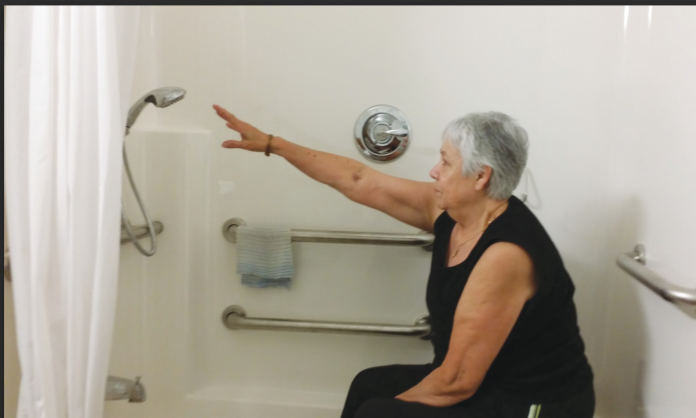
Remodeling at a Gilroy low-income housing complex has left apartments with bathrooms inaccessible to handicapped residents, a violation of federal law according to one man.
A city inspector signed off on upgrades at the Plum Tree West apartments on Montebello Drive, but the work does not comply with the Americans With Disabilities Act (ADA) designed to ensure access indoors and outside for the handicapped, resident Tim Holliday alleged.
Holliday, 41, has been wheelchair bound for 30 years because of an affliction that causes spasms that paralyze his legs.
“They took away the showers and put in bathtubs and they put plates over emergency buttons so we can no longer use them,” Holliday said.
“A young man in a wheelchair fell down in his tub and now he uses a neighbor’s shower, another man is 94,” said Sally Armendariz of the Community Agency for Resources, Advocacy and Services, or CARAS, the Gilroy nonprofit assisting complex residents, some of whom have live-in caregivers.
At least 15 residents whose apartments have been remodeled so far in the 70-unit complex met last week to compare notes, which mostly concern bathrooms but include other complaints, such as access to stoves.
Violet Guliza is 90. She has severe arthritis in her legs and needs a walker to get around. Before the remodel, her one-bedroom, one-bathroom unit had a walk-in shower that made getting in and out easy despite her disability, she said.
But showers were replaced by tubs with shower heads and Guliza cannot lift her legs high enough to step over and into the tub, she said.
“I can’t even understand why they remodeled it,” Guliza said, noting her apartment was in good condition before the work.
Residents were given checks for hotels and meals then moved out of their units during the initial two-week project, according to Holliday and Guliza. They stayed with relatives.
Their units were remodeled in early May and others are under construction now, they said.
At Gilroy City Hall, community development director Kristi Abrams said the city “absolutely” will revisit the apartment if residents request a re-inspection. She said none of the residents have called her about the issue.
However, she said, “There is no code requirement that the city can enforce so the units are accessible. We have no legal remedy, the code has no requirement for all units to be accessible in any type of complex.”
She said the city inspector who approved the remodels is its specialist on such matters, although she said he still is working at getting official certification as an access specialist.
The complex is for income-qualified people age 62 and over. It’s insured and operated under rules administered by the U.S. Department of Housing and Urban Development (HUD) and is owned by Preservation Partners Management Group Inc. of Torrance, California.
That development group specializes in the acquisition, rehabilitation and preservation of HUD and California Housing Finance Agency insured and assisted affordable housing developments, according to its website.
“PPD provides the opportunity to rehabilitate and permanently preserve existing affordable housing assets by offering owners the opportunity to realize ‘market values’ upon sale. Since our formation in 1999, we have utilized low-income housing tax credits and tax-exempt bond financings to acquire and rehabilitate 29 properties representing 3,130 rental units in Washington, Virginia and throughout California,” the website reads.
The firm did not return calls requesting comment on complaints by the Plum Tree West residents.
To support his contention that the newly installed features do not comply with federal law, Holliday cited a top federal law enforcement agency on the matter of bathtub controls.
“I found a 2010 ADA Standards for Accessible Design from the Department of Justice,” he wrote in an email. “According to section 607.5 it reads: ‘Controls, other than drain stoppers, shall be located on an end wall. Controls shall be between the bathtub rim and grab bar, and between the open side of the bathtub and the centerline of the width of the bathtub.”
The newly installed tubs all have control knobs on the far back wall. They are unreachable by people with disabilities, according to Holliday and Guliza.
Other problems involve shower heads that are mounted just over four feet off the floor, which Holliday says is too low; inaccessible garbage disposals and ovens whose design make it impossible for him to reach the racks from his wheelchair when the door is open.
Abrams said she wants to review the Justice Department citation. She cautioned that such sections cannot be taken out of context and have to be considered along with other parts of the law.
“I’m not saying it’s right or wrong. We cannot just take little abstract out, we have to look at the whole (ADA),” she said.













